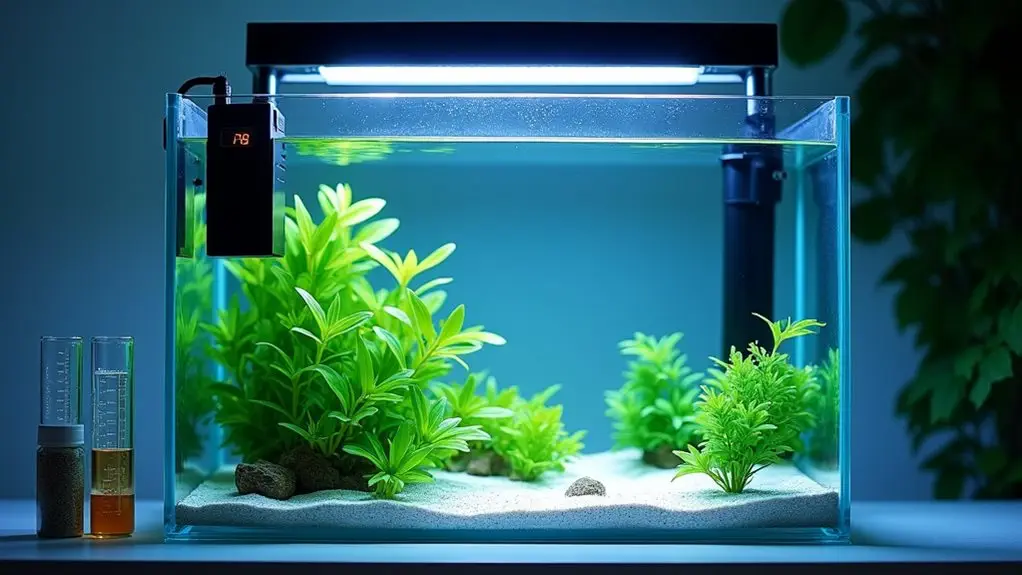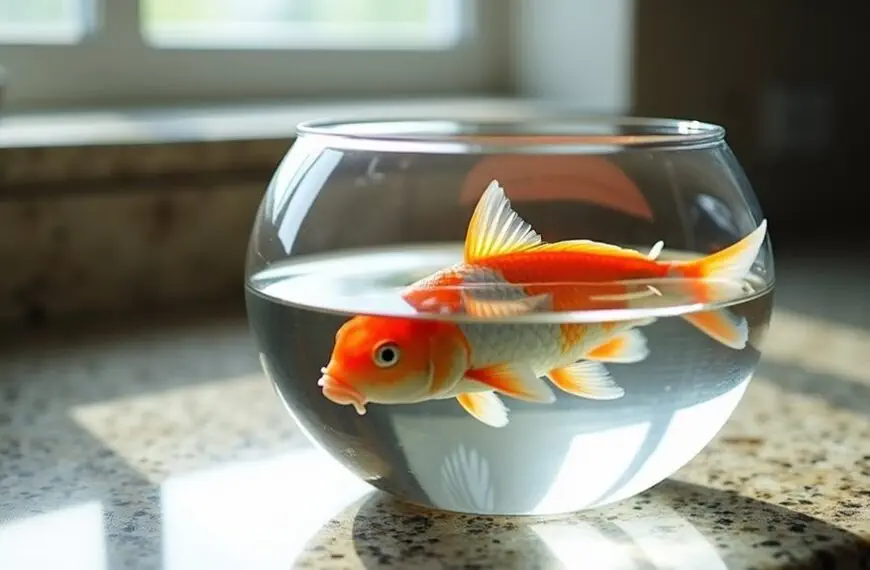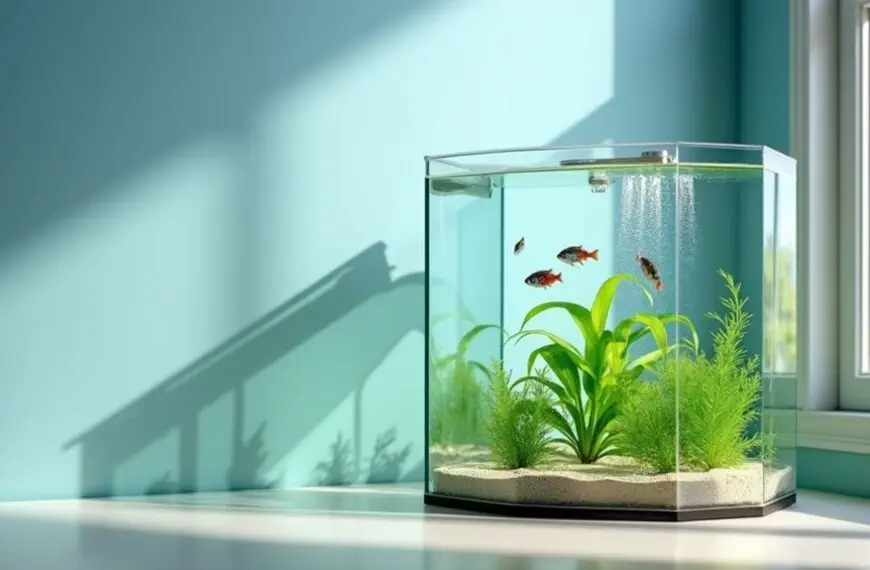To maintain your first fish tank, you'll need essential equipment like a reliable filter, heater, and proper lighting to create a healthy environment. Start by cycling your tank to establish beneficial bacteria, and test water parameters weekly using a quality test kit – keeping ammonia and nitrites at 0 ppm. Perform 10-15% water changes weekly, using dechlorinated water, and develop a daily routine of checking equipment, feeding fish appropriately, and monitoring their behavior. Clean your tank regularly with an algae scraper and gravel vacuum, and remember to never use household cleaners. There's much more to successful fish keeping than meets the eye, but these basics will set you on the right path.
Contents
- 1 Essential Equipment and Setup
- 2 Water Quality Basics
- 3 Daily and Weekly Tasks
- 4 Creating a Maintenance Schedule
- 5 Safety During Tank Care
- 6 Frequently Asked Questions
- 6.1 How Long Should I Wait Before Adding New Fish to My Tank?
- 6.2 What Should I Do if My Fish Suddenly Stop Eating?
- 6.3 Can I Use Regular Tap Water for Emergency Water Changes?
- 6.4 How Do I Safely Introduce Live Plants to My Aquarium?
- 6.5 Why Is My Aquarium Water Turning Green Despite Regular Maintenance?
- 7 Final Thoughts
Essential Equipment and Setup
Setting up a successful fish tank starts with having the right equipment. When choosing your aquarium, you'll need to take into account both tank materials and size requirements. Glass tanks offer excellent scratch resistance and durability, while acrylic provides better insulation but can scratch more easily.
For most beginners, a tank of at least 16 gallons works well, though betta fish can thrive in a 5-gallon setup. Regular water changes biweekly help maintain optimal conditions for your fish.
Your filtration system is absolutely essential for maintaining healthy water conditions. You'll find various filter types to choose from, including hang-on-back filters (perfect for beginners), canister filters (great for larger tanks), and gentle sponge filters (ideal if you're planning to keep baby fish or shrimp). Sponge filters are particularly beneficial as they provide gentle biological filtration while being cost-effective for multiple tanks.
Here's a pro tip: always go bigger with your filter – aim for one rated at double your tank size!
Don't forget about temperature control and lighting. You'll need a reliable heater unless your room stays consistently between 74-77°F, and energy-efficient LED lights will keep your tank well-lit without heating the water.
Remember to grab essential maintenance tools like a siphon for cleaning and an algae scraper – trust me, you'll thank yourself later!
Water Quality Basics
Now that you've got your equipment ready, maintaining proper water quality will determine your aquarium's success. Think of your fish tank as a tiny underwater city where everything needs to be in perfect balance. Your main focus should be on monitoring pH stability and water hardness, which are like the crucial signs of your aquatic environment. Regular testing with test kits can help prevent water quality disasters.
You'll want to keep your pH levels between 6.5 and 8.2, though most freshwater fish are happiest in the 6.0-7.0 range. Water hardness might sound complicated, but don't worry – you're just measuring mineral content. Aim for general hardness between 100-250 mg/L, and you'll be on the right track. Live aquatic plants can significantly improve your water quality by absorbing excess nutrients, while beneficial bacteria in your biological filter help break down waste.
Here's where it gets interesting: your tank has its own little ecosystem called the nitrogen cycle. You'll need to keep ammonia at 0 ppm (trust me, your fish will thank you), nitrites between 0-10 ppb, and nitrates below 30 ppm.
Weekly water changes of 10-15% are your best friend here – they're like giving your tank a refresh button! Don't forget to use a water conditioner to make tap water safe, and test your water parameters weekly. It's easier than baking a cake, and much more rewarding!
Daily and Weekly Tasks
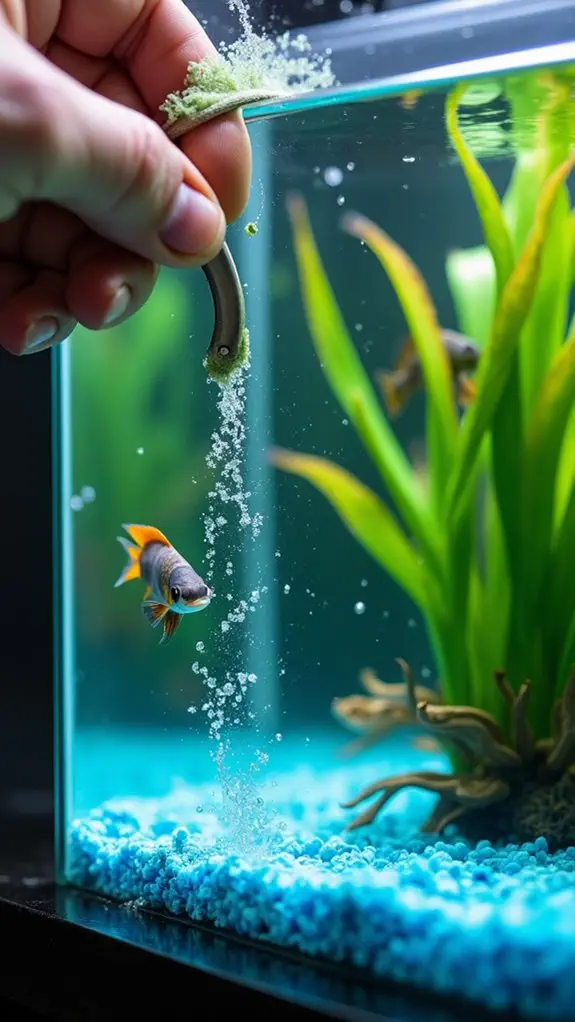
Immerse yourself in your aquarium maintenance with a simple daily and weekly routine that'll keep your fish thriving.
Each day, you'll want to check your equipment, observe fish behavior for any unusual signs, and maintain tank aesthetics by wiping down the glass. Automatic feeders can help maintain consistent feeding schedules, but daily oversight is still important. Don't forget to feed your finned friends according to schedule and keep an eye on that temperature gauge! Consider installing EcoBio-Stone products to support beneficial bacteria growth in your aquarium.
Your weekly tasks are a bit more involved, but they're essential for a healthy aquarium.
Plan to change 15-25% of the water while vacuuming the gravel – it's like giving your tank a mini spa day! You'll want to pay special attention to those hidden spots under decorations where debris loves to hide.
When you're replacing the water, always use dechlorinated tap water to keep your fish comfortable.
While you're at it, take time to count your underwater crew and give your equipment a thorough once-over.
Don't forget about algae control – those green spots can be persistent little troublemakers! Clean your filter inserts with the water you've removed, and test those critical water parameters.
Think of it as giving your aquatic paradise a weekly health check-up.
Creating a Maintenance Schedule
A well-organized maintenance schedule serves as your roadmap to a thriving aquarium.
You'll want to break down your tasks into daily, weekly, and monthly routines, making tank maintenance feel less overwhelming and more manageable. Think of it as giving your underwater friends a regular spa day! Remember to maintain the water temperature 75°-80°F for optimal fish health. Be sure to keep your skimmer cup clean every week to maintain proper water quality. Regularly changing the water helps to reduce ammonia and nitrites, ensuring a healthier environment for your fish.
Start by checking your equipment daily – it's as simple as ensuring your pumps, filters, and lights are working properly.
When it comes to weekly maintenance tips, plan to change 15-25% of the water and give the tank a thorough cleaning. Don't forget to test water parameters regularly; your fish will thank you for it!
For monthly tasks, you'll need to tackle deeper cleaning jobs like scrubbing algae and inspecting equipment for any necessary tank modifications.
Safety During Tank Care
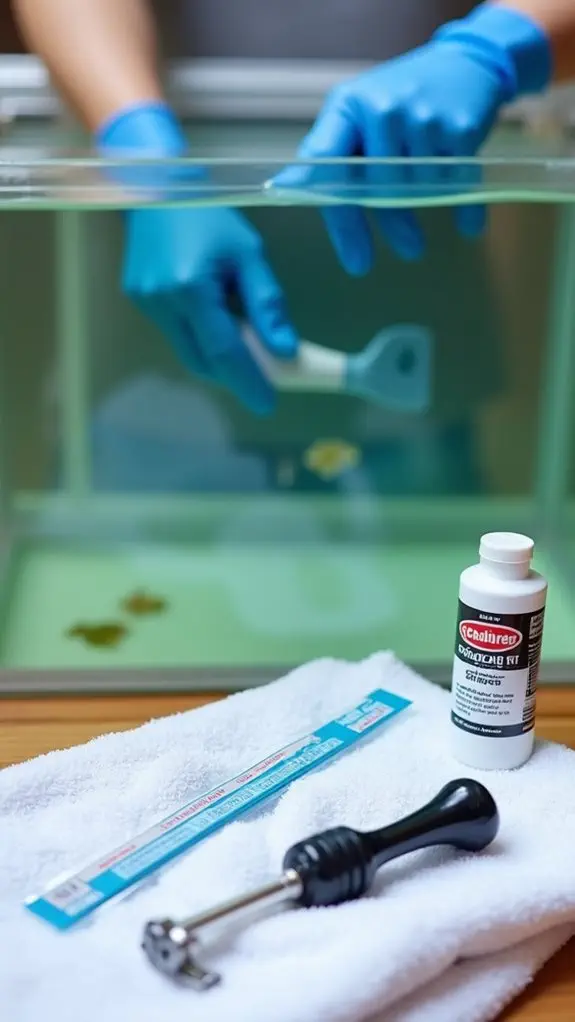
Maintaining a fish tank requires careful attention to multiple safety considerations that protect both you and your aquatic pets. When you're working on your tank, remember that electrical safety is paramount – always create drip loops in your cords and unplug equipment before reaching into the water. Testing water parameters weekly using appropriate test kits helps ensure water quality stability, which is crucial for the overall health of your fish.
You'll also want to focus on biological safety by wearing gloves and washing your hands thoroughly after any tank maintenance. Harmful bacteria can thrive in aquarium water and potentially cause infections if proper precautions aren't taken, so maintaining optimal water quality becomes an essential part of tank care.
To keep yourself and your finned friends safe, here are essential practices you should follow:
- Mount all electrical equipment securely and use grounding probes to prevent shock hazards.
- Place your tank on a sturdy, level stand that can support the full weight (remember: water's heavy!).
- Keep chemicals stored safely away from children and pets, and never use household cleaners in your tank.
- Always quarantine new fish before adding them to your main tank to prevent disease spread.
Don't forget that even simple tasks like water changes can create slip hazards, so keep towels handy to wipe up spills.
While maintaining your aquarium isn't rocket science, treating it with respect will guarantee everyone stays safe and happy – fins and fingers alike!
Frequently Asked Questions
How Long Should I Wait Before Adding New Fish to My Tank?
You should wait 24-48 hours minimum, but it's best to wait a week while the cycling process completes. Monitor your tank conditions for 2 weeks before adding fish to guarantee a safe environment.
What Should I Do if My Fish Suddenly Stop Eating?
First, monitor your fish's behavior and check water parameters. If feeding habits change suddenly, look for signs of stress or illness. Don't overfeed – skip meals for a day, then try small amounts.
Can I Use Regular Tap Water for Emergency Water Changes?
Don't use untreated tap water. You'll need to add water conditioning products first to neutralize harmful chemicals. Test your tap water quality, match the temperature, and treat it before adding to your aquarium.
How Do I Safely Introduce Live Plants to My Aquarium?
Start with proper plant selection, choosing hardy species like Anubias or Java Moss. Prepare your substrate carefully, then rinse plants thoroughly before planting. You'll want to anchor them securely and provide appropriate lighting.
Why Is My Aquarium Water Turning Green Despite Regular Maintenance?
Your tank's green water is likely due to an algae bloom triggered by excess light and poor water quality. You'll need to reduce lighting, perform larger water changes, and monitor nutrient levels closely.
Final Thoughts
Maintaining your first fish tank doesn't need to be overwhelming. You've learned the essential equipment, water quality basics, and daily tasks needed to keep your aquatic friends healthy and happy. By sticking to your maintenance schedule and following safety guidelines, you'll be a confident fish keeper in no time. Remember, consistency is key – and soon enough, you'll find that caring for your underwater world becomes second nature.

